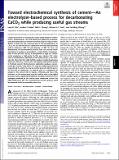| dc.contributor.author | Ellis, Leah D. | |
| dc.contributor.author | Badel, Andres F. | |
| dc.contributor.author | Chiang, Miki L. | |
| dc.contributor.author | Park, Richard J.-Y. | |
| dc.contributor.author | Chiang, Yet-Ming | |
| dc.date.accessioned | 2020-03-31T15:56:11Z | |
| dc.date.available | 2020-03-31T15:56:11Z | |
| dc.date.issued | 2019-09-16 | |
| dc.identifier.issn | 0027-8424 | |
| dc.identifier.issn | 1091-6490 | |
| dc.identifier.uri | https://hdl.handle.net/1721.1/124452 | |
| dc.description.abstract | Cement production is currently the largest single industrial emitter of CO₂, accounting for∼8% (2.8 Gtons/y) of global CO₂ emissions.Deep decarbonization of cement manufacturing will require remediation of both the CO₂ emissions due to the decomposition of CaCO₃ to CaO and that due to combustion of fossil fuels (primarily coal) in calcining (∼900 °C) and sintering (∼1,450 °C). Here, we demonstrate an electrochemical process that uses neutral water electrolysis to produce a pH gradient in which CaCO₃is decarbonated at low pH and Ca(OH)₂ is precipitated at high pH, concurrently producing a high-purity O₂/CO₂ gas mixture (1:2 molarratio at stoichiometric operation) at the anode and H₂ at the cathode. We show that the solid Ca(OH)₂ product readily decomposes and reacts with SiO₂ to form alite, the majority cementitious phasein Portland cement. Electrochemical calcination produces concentrated gas streams from which CO₂ may be readily separated and sequestered, H₂ and/or O₂ may be used to generate electric power via fuel cells or combustors, O₂ may be used as a component ofoxyfuel in the cement kiln to improve efficiency and lower CO₂ emissions, or the output gases may be used for other value-added processes such as liquid fuel production. Analysis shows that if the hydrogen produced by the reactor were combusted to heat the high-temperature kiln, the electrochemical cement process could be powered solely by renewable electricity. | en_US |
| dc.description.sponsorship | Skolkovo Institute of Science and Technology (contract 186-MRA) | en_US |
| dc.description.sponsorship | National Science Foundation (U.S.) (award MR-1419807) | en_US |
| dc.language.iso | en | |
| dc.publisher | Proceedings of the National Academy of Sciences | en_US |
| dc.relation.isversionof | 10.1073/pnas.1821673116 | en_US |
| dc.rights | Article is made available in accordance with the publisher's policy and may be subject to US copyright law. Please refer to the publisher's site for terms of use. | en_US |
| dc.source | PNAS | en_US |
| dc.subject | Multidisciplinary | en_US |
| dc.title | Toward electrochemical synthesis of cement—An electrolyzer-based process for decarbonating CaCO₃ while producing useful gas streams | en_US |
| dc.type | Article | en_US |
| dc.identifier.citation | Ellis, Leah D. et al. "Toward electrochemical synthesis of cement—An electrolyzer-based process for decarbonating CaCO₃ while producing useful gas streams." Proceedings of the National Academy of Sciences of the United States of America 2019: 1821673116 © 2019 The Author(s) | en_US |
| dc.contributor.department | Massachusetts Institute of Technology. Department of Materials Science and Engineering | en_US |
| dc.relation.journal | Proceedings of the National Academy of Sciences of the United States of America | en_US |
| dc.eprint.version | Final published version | en_US |
| dc.type.uri | http://purl.org/eprint/type/JournalArticle | en_US |
| eprint.status | http://purl.org/eprint/status/PeerReviewed | en_US |
| dc.date.updated | 2020-02-11T13:39:48Z | |
| dspace.date.submission | 2020-02-11T13:39:50Z | |
| mit.license | PUBLISHER_POLICY | |
| mit.metadata.status | Complete | |
